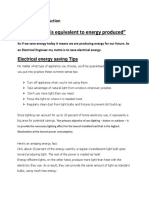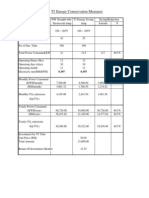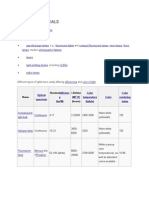Catagories Led Incadescent: 50,000 Hours 1,200 Hours 6 - 8 Watts 60 Watts 329 Kwh/Yr. 3285 Kwh/Yr. 1645 16425
Catagories Led Incadescent: 50,000 Hours 1,200 Hours 6 - 8 Watts 60 Watts 329 Kwh/Yr. 3285 Kwh/Yr. 1645 16425
Uploaded by
Sayantan RoyCopyright:
Available Formats
Catagories Led Incadescent: 50,000 Hours 1,200 Hours 6 - 8 Watts 60 Watts 329 Kwh/Yr. 3285 Kwh/Yr. 1645 16425
Catagories Led Incadescent: 50,000 Hours 1,200 Hours 6 - 8 Watts 60 Watts 329 Kwh/Yr. 3285 Kwh/Yr. 1645 16425
Uploaded by
Sayantan RoyOriginal Title
Copyright
Available Formats
Share this document
Did you find this document useful?
Is this content inappropriate?
Copyright:
Available Formats
Catagories Led Incadescent: 50,000 Hours 1,200 Hours 6 - 8 Watts 60 Watts 329 Kwh/Yr. 3285 Kwh/Yr. 1645 16425
Catagories Led Incadescent: 50,000 Hours 1,200 Hours 6 - 8 Watts 60 Watts 329 Kwh/Yr. 3285 Kwh/Yr. 1645 16425
Uploaded by
Sayantan RoyCopyright:
Available Formats
Catagories Life Span Watts of electricity used (equivalent to 60 watt bulb) Kilo-watts of Electricity used (30 Incandescent Bulbs
per year equivalent) Annual Operating Cost (30 Incandescent Bulbs per year equivalent) @ 5/unit Environtmental Impact Contains the TOXIC Mercury Carbon Dioxide Emissions (30 bulbs per year) Lower energy consumption decreases: CO2 emissions, sulfur oxide, and high-level nuclear waste. On/off Cycling (Flickering) Durability Failure Modes
LED 50,000 hours 6 - 8 watts 329 KWh/yr. 1645 No 202.95 No Effect
Incadescent 1,200 hours 60 watts 3285 KWh/yr. 16425 No 2025 Some
Very Durable - LEDs Not Very Durable - glass can handle jarring and or filament can break bumping easily Not typical LED Watts 4 to 5 5 to 8 9 to 13 Some Incadescent Watts 40 60 75
Lumens 450 650 1,100
CFL 8,000 hours 13-15 watts 767 KWh/yr 3835 Yes 472.95 Yes - can reduce lifespan drastically Not Very Durable - glass can break easily Yes - may catch on fire, smoke, or omit an odor CFL Watts 9 to 13 9 to 12 18 to 25
Comments LEDs use less power (watts) per unit of light generated (lumens). LEDs help reduce greenhouse gas emissions from power plants and lower electric bills NA Savings is 50% of CFL usage NA NA 57% reduction in Carbon emissions compared to CFL NA NA NA
For a offcie like ours where we have both equal amount of paper work and working on computer Lumen of 550 to 650 is ideal.
You might also like
- WWW Designrecycleinc Com Led Comp ChartDocument2 pagesWWW Designrecycleinc Com Led Comp Chartrsiva98No ratings yet
- Comparison Chart Led Lights vs. Incandescent Light Bulbs vs. CflsDocument3 pagesComparison Chart Led Lights vs. Incandescent Light Bulbs vs. CflsMayank SinghNo ratings yet
- Comparison Chart Led Lights vs. Incandescent Light Bulbs vs. CflsDocument6 pagesComparison Chart Led Lights vs. Incandescent Light Bulbs vs. CflsPankaj ShidurkarNo ratings yet
- Comparisan LED Vs PLC Vs IncandescentDocument2 pagesComparisan LED Vs PLC Vs IncandescentRizal IdrisNo ratings yet
- Comparison Chart LED CFL ILDocument5 pagesComparison Chart LED CFL ILVer BautistaNo ratings yet
- Energy Efficiency & Energy Costs: Comparison Chart Led Lights vs. Incandescent Light Bulbs vs. CflsDocument2 pagesEnergy Efficiency & Energy Costs: Comparison Chart Led Lights vs. Incandescent Light Bulbs vs. Cflspditzel8599No ratings yet
- Light Output Leds Cfls Incandescents 450 750 - 900 1100 - 1300 1600 - 1800 2600 - 2800Document2 pagesLight Output Leds Cfls Incandescents 450 750 - 900 1100 - 1300 1600 - 1800 2600 - 2800TeJas PaTelNo ratings yet
- Our PartnerDocument18 pagesOur PartnerEvelyn MendozaNo ratings yet
- SL DesignDocument3 pagesSL DesignJer A' MealNo ratings yet
- Multi-Lite Led-Retrofits en Intl June2010 Ge Philips OsramDocument36 pagesMulti-Lite Led-Retrofits en Intl June2010 Ge Philips OsramMohit SethiNo ratings yet
- Comparison Chart Led Lights vs. Incandescent Light Bulbs vs. CflsDocument4 pagesComparison Chart Led Lights vs. Incandescent Light Bulbs vs. CflsK Vijay Bhaskar ReddyNo ratings yet
- Led PresentationDocument28 pagesLed PresentationhemadribabuNo ratings yet
- ImmaculateLED CatalogueDocument2 pagesImmaculateLED CatalogueRajbir Singh YadavNo ratings yet
- Comparison Chart LED CFL ILDocument5 pagesComparison Chart LED CFL ILver_at_workNo ratings yet
- Low Pressure SodiumDocument10 pagesLow Pressure SodiumCyrus JainNo ratings yet
- Induction LightingDocument2 pagesInduction Lightingnosyparker619No ratings yet
- Comparison Chart LED CFL ILDocument5 pagesComparison Chart LED CFL ILver_at_workNo ratings yet
- Eup Legislation Philips OemDocument8 pagesEup Legislation Philips OemAndrei GhitaNo ratings yet
- Elba Catalog Led Eng1Document40 pagesElba Catalog Led Eng1Adrian MargescuNo ratings yet
- Seminar OnDocument25 pagesSeminar OnJayant DeshmukhNo ratings yet
- Artificial LightingDocument37 pagesArtificial LightingRanu AgarwalNo ratings yet
- Trade LED SolutionsDocument64 pagesTrade LED Solutionsneopro811No ratings yet
- 02 - Izvori SvjetlaDocument23 pages02 - Izvori SvjetlaRanko SkansiNo ratings yet
- "Energy Saved Is Equivalent To Energy Produced": Chapter 1-IntroductionDocument33 pages"Energy Saved Is Equivalent To Energy Produced": Chapter 1-IntroductionRamyata MahajanNo ratings yet
- Street Lighting Sales BrochureDocument2 pagesStreet Lighting Sales BrochureSyarina MaatNo ratings yet
- Top 10 Benefits of LED LightingDocument8 pagesTop 10 Benefits of LED LightingVIKAS BHANDARENo ratings yet
- Osram CatálogoDocument32 pagesOsram CatálogoMarcos M. CastilhoNo ratings yet
- Primamax PVT LTDDocument30 pagesPrimamax PVT LTDSalman HashmiNo ratings yet
- Cost Comparison Between LEDsDocument5 pagesCost Comparison Between LEDsnaleengtNo ratings yet
- Lighting Maintenance: Action ChecklistDocument12 pagesLighting Maintenance: Action ChecklistBudeanu SergiuNo ratings yet
- Think Led Product CatalogueDocument12 pagesThink Led Product Catalogueinfo7390No ratings yet
- Green Building With RefDocument11 pagesGreen Building With RefRahul KumarNo ratings yet
- GE EUP Brochure FinalDocument2 pagesGE EUP Brochure FinalPaul DavidsonNo ratings yet
- CFL vs. Led: A Few More Facts: CflsDocument5 pagesCFL vs. Led: A Few More Facts: CflsAira VeniceNo ratings yet
- 1 LED LightingDocument44 pages1 LED LightingKanagha Raj KNo ratings yet
- Lighting Sources and Their Applications: Light Fixture Lumens Example UsesDocument5 pagesLighting Sources and Their Applications: Light Fixture Lumens Example UsesTanmay JagetiaNo ratings yet
- Led Lighting Is ThornDocument88 pagesLed Lighting Is ThornhansdubarryNo ratings yet
- Brosur Lampu LEDDocument17 pagesBrosur Lampu LEDEko Yuli Sulistiono0% (1)
- T5 Ion DataDocument1 pageT5 Ion DatachillermaniacNo ratings yet
- Chosen Problems of Light Technics in The TransportDocument35 pagesChosen Problems of Light Technics in The TransportNazim KaraosmanogluNo ratings yet
- Lighting Materials and FixturesDocument11 pagesLighting Materials and FixturesMichael Root100% (1)
- Induction and LED Lighting: An Overview of Interior ApplicationsDocument18 pagesInduction and LED Lighting: An Overview of Interior ApplicationsShantkumar S SambargimathNo ratings yet
- The Advantages of Magnetic Induction LampsDocument7 pagesThe Advantages of Magnetic Induction LampsnntoolNo ratings yet
- Questions & Answers - LED Lighting: What Are LED Bulbs?Document3 pagesQuestions & Answers - LED Lighting: What Are LED Bulbs?ياسين حسينNo ratings yet
- Bao Chau Profile PDFDocument21 pagesBao Chau Profile PDFVăn CuộcNo ratings yet
- Osram PDFDocument407 pagesOsram PDFkhawar mukhtarNo ratings yet
- Soluxio, The Advanced Solar Lighting SystemDocument2 pagesSoluxio, The Advanced Solar Lighting SystemPole Products (formerly Sapa)No ratings yet
- Starlight LED Lamps Spec SheetDocument4 pagesStarlight LED Lamps Spec Sheetpalanirban2563No ratings yet
- Types of Lamps and LightingDocument52 pagesTypes of Lamps and LightingKevin Ndeti100% (1)
- Master Ledspots MV Gu10 Non-Dimmable Master Ledspots MV Gu10 DimmableDocument1 pageMaster Ledspots MV Gu10 Non-Dimmable Master Ledspots MV Gu10 DimmableTB11SDNo ratings yet
- Jan2015 V4 Cat Updated 12.25.14 LoDocument73 pagesJan2015 V4 Cat Updated 12.25.14 Lomenochem1No ratings yet
- LED Fluorescent Tube Brochure, Specialized Lighting ConceptsDocument2 pagesLED Fluorescent Tube Brochure, Specialized Lighting ConceptsSpecialized Lighting Concepts100% (1)
- What Is Useful Life For White Light Leds? Lighting Research CenterDocument12 pagesWhat Is Useful Life For White Light Leds? Lighting Research CenterAbigail RamosNo ratings yet
- Kingstar Lighting InductionDocument8 pagesKingstar Lighting Inductionapi-194673166No ratings yet
- Induction Lamp TechnologyDocument1 pageInduction Lamp TechnologythomhankNo ratings yet
- Led Fundamentals: Luminous EfficacyDocument10 pagesLed Fundamentals: Luminous EfficacyKalp KartikNo ratings yet
- Lighting Comparison Chart PDFDocument2 pagesLighting Comparison Chart PDFpaul_aldNo ratings yet
- Sustainable Energy EfficiencyDocument5 pagesSustainable Energy EfficiencyAEEENo ratings yet
- Led Bulbs CatalogueDocument30 pagesLed Bulbs CatalogueleedarsonlightingNo ratings yet
- LED Lighting for your Home & Business: LED Lights Save Money and Make Your Home Lighting SpectacularFrom EverandLED Lighting for your Home & Business: LED Lights Save Money and Make Your Home Lighting SpectacularRating: 4 out of 5 stars4/5 (1)



























































